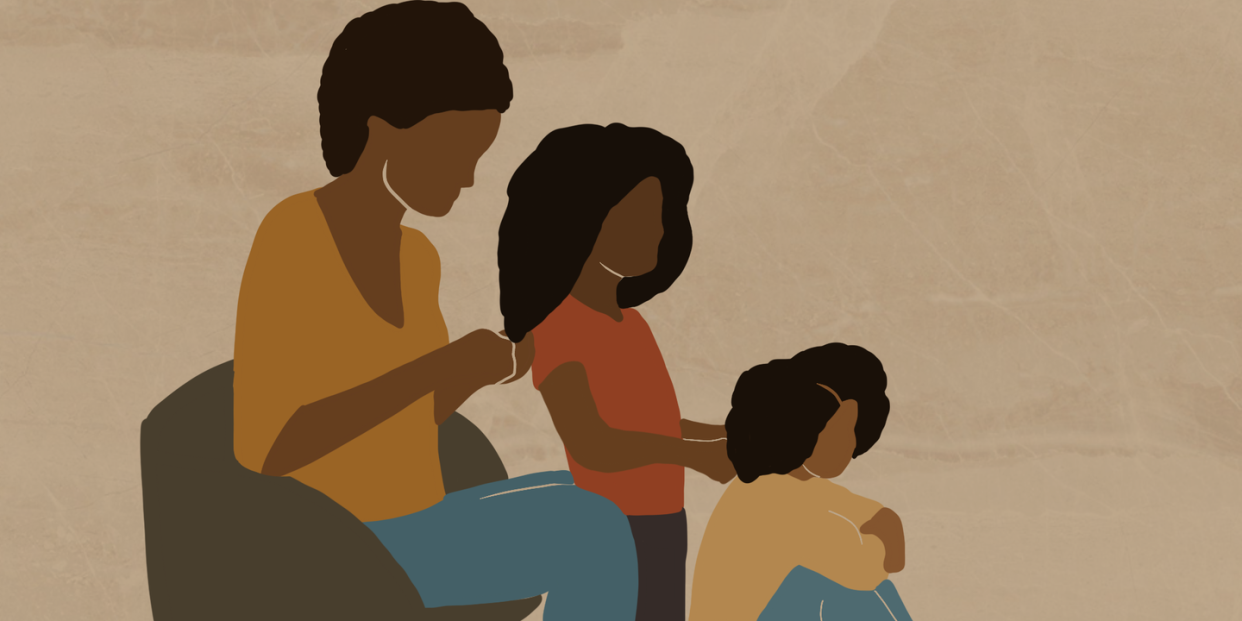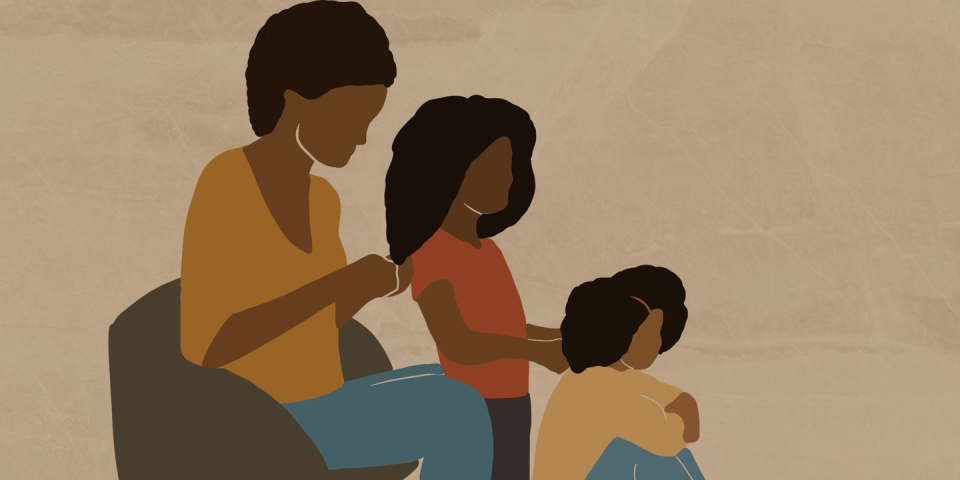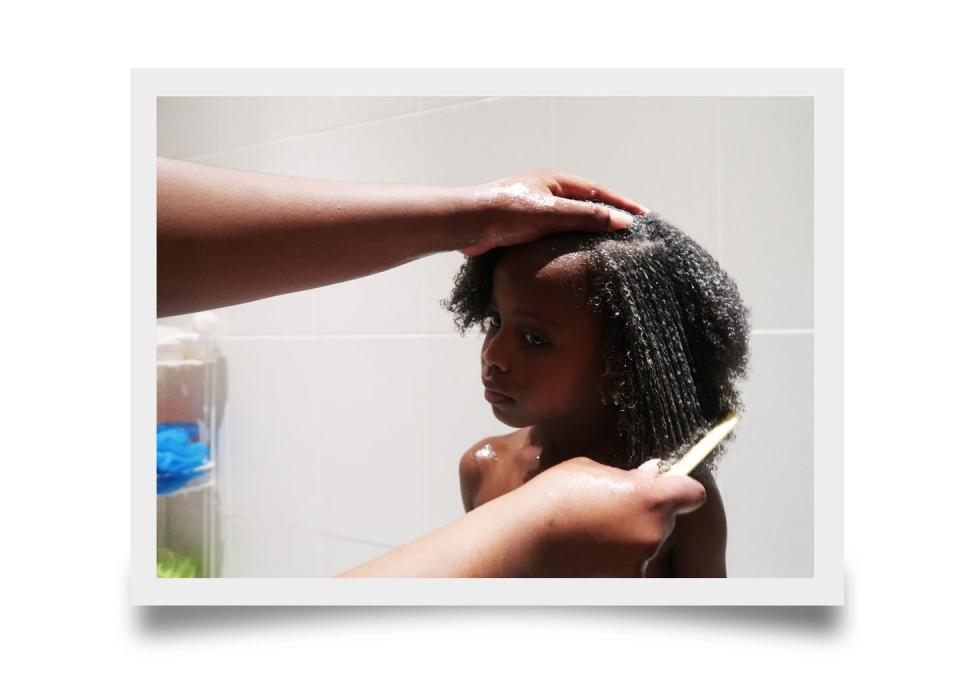'I learned to love my Afro hair and now I'm teaching my daughters to celebrate theirs'


During Black History Month – and always, for that matter – it's important that we take time to reflect on the stories of members of the Black community, and celebrate the vast contributions the community has made. In this piece, writer and mum Joy Ejaria explores the subject of Black hair, examining her relationship with her own, as well as sharing how she's teaching her daughters to love theirs.
Nappy, coarse and tough are just a few of the words often used to describe Afro-textured hair. As someone with this type of hair, I find these word choices perplexing.
The assumption that Afro hair is tough is wrong on so many levels because scientifically, Afro hair is actually the most fragile hair texture, hence why protective styling is incorporated into its care routine. This sort of flawed mindset is rife in the beauty community, thanks to the Eurocentric ideals beauty brands adhere to.
On the bottles of shampoo or conditioner catering to Afro hair, it’s normal to see words like ‘unmanageable’ or ‘damaged’ used to describe the hair the product is perfect for. So it’s understandable that those with Afro hair then become conditioned to this type of thinking. As a mother to two little girls with textured hair, I’m working hard to ensure they don't internalise this negative messaging and learn to love their hair.
From ‘fros to frizz, kinks and coils or even curls and waves, Black hair comes in all shapes and sizes, that’s why the hair classification system created by Oprah Winfrey’s hair stylist, Andre Walker, was a welcomed innovation. Unlike Eugene Fischer hair gauge, which was created in the early 1900s to judge the relative ‘whiteness’ of mixed-race people according to hair colour and texture, this system helps to clear up confusion and enable people to find products best suited for their hair type.
The Andre Walker Hair Typing System starts at 1, which is pinstripe straight, and goes all the way through to 4c which can be likened to a slinky toy in terms of the shape of the curls. I fall under the latter. My curls are tight, with no definition. My hair looks short, though when stretched out, it's pretty long.
My eldest daughter has hair just like mine and my other daughter falls between 3c and 4a, a texture that allows her hair to be described as curly rather than coily. Her curls sit well-defined on her hair with freedom of movement when brushed.
From a very young age, people had already begun making comparisons between my girls, with discriminatory undertones about their hair and statements connoting that the sister with the 4c texture had ‘bad’ hair. As a parent, this sort of thing can be dispiriting, so I can only imagine how it made her feel. I like to avoid talking about this with her because I feel it will greatly highlight the difference. But every so often, when she mentions how she 'hates her hair' or wishes she had hair like a particular celebrity with looser curls, I remind her that her hair is unique to her, and has the potential to do much more than she believes it can.
I also believe visual representation plays a huge role in how kids see themselves, so I combat her negative thought process by showing her images of my hair through the years and hope with time, she can grow to love hers the way I now love mine.
I remember when I realised I had Afro hair, I was 10 years old on the playground of a south London primary school when a classmate pointed out the sponge-like texture of my hair and how she couldn’t easily style it in the same way she did for the others.
For many Black women, like myself, this is often the first experience that makes us feel othered, different from those around us at school. My friends have had it and more recently my kids, too. It’s a sad and painful eye-opener.

For Black girls growing up, it's common to spend Saturdays at the hair shop, either getting a relaxer or braids done whilst listening to Auntys have conversations they know they shouldn’t be listening too.
I still vividly remember when I first got my hair relaxed. I was five, it was almost Christmas and my mum wanted me to have ‘nice’ hair so she took me to the hairdressers. One of the reasons why I so clearly remember that day is down to the pain I felt during the process. For those not familiar with what a perm is for Black hair – it’s the process of semi-permanently straightening Afro hair using a chemical formula commonly referred to as ‘relaxer’.
Since such harsh routines were introduced to me from such a young age, I, like other Black girls, have become accustomed to the idea that ‘beauty is pain’. Every six to eight weeks, I would visit a professional to go through the excruciating ordeal of straightening my hair to meet the Western ideal of beauty.
Throughout secondary school, I wore my hair in neatly braided cornrows. On the off chance that my hair wasn’t in this protective hairstyle, it was due to be relaxed. By the time I’d hit college, I began experimenting with my hair, in a bid to fully understand what exactly it could do. I started off with weaves, though got irritated by them so quickly it led to a pixie cut that stayed around for many years.
In the mid-2000s, a social movement began and thanks to social media it spread across the world. Black women were encouraged to embrace their natural, Afro hair. Hashtags were launched, tutorials uploaded and products concocted. United, Black women stood in defiance of the idea that good hair equalled straight hair.
Without so much as a backward glance, I followed suit. With a pair of scissors, I chopped off all my hair, and my, did it feel liberating. It took 21 years and a social movement for me to realise the true potential of my hair. As it was still very early on in the movement, friends and family thought I was going through some sort of life crisis. They couldn’t grasp how I could have cut off all my hair with no remorse. It was easier to think I was going through some sort of mental illness than for me to choose to wear my hair in the natural state in which it grows from my scalp.
Author and academic Emma Dabiri clearly states in her book, Don’t Touch My Hair, that Black hair is never just hair. For Black women especially, it's much more complex than that. We are over-criticised for everything we do, but when it comes to our hair, this is done with a fine-tooth comb. It's the reason why there’s often an uproar when a non-Black woman chooses to wear her hair in a style traditionally worn by Black women. Take Kim Kardashian for example, who time and time again, has been accused of culturally appropriating Black culture, by wearing braids and being praised for styles Black women are condemned for.
Across the world, Black girls have historically been and continue to be chastised due to their hair.

In 2019, California became the first American state to introduce a law (the CROWN Act) that essentially makes hair discrimination illegal and since then, other states like New York have followed suit.
In the UK however, Black and mixed heritage children don’t stand a chance, with many being given heavy-handed punishments spanning as far as exclusion from school. I’ve had friends with primary school children who have been given a warning letter or had their child sent home due to hair-related issues. Unlike our friends across the pond, the UK has no law like the CROWN Act; instead cases relating to hair discrimination fall under the Equality and Human Rights Commission. Earlier this year, Ruby Williams, a student from east London received an out-of-court £8,500 settlement after claims her school said her hair breached school uniform policy. Ruby's school, The Urswick School, did not accept liability and told BBC's Newsbeat: "The governing body is hugely distressed if any child or family feels we have discriminated against them... We do not accept that the school has discriminated, even unintentionally, against any individual or group."
In The Journal of Southern History, under the section ‘Slave Hair and African American Culture in the Eighteenth and Nineteenth Centuries’, writers Shane White and Graham White noted that “the way African American slaves styled their hair was important to them as individuals, and it also played a substantial role in their communal life”.
So for schools and organisations to discipline people unfairly due to their hair choices takes away from something that makes them fundamentally Black. In a Women’s Health Magazine interview in 2020, Dr Tricia Wolanin, clinical psychologist, says the reason hair discrimination is still prevalent is because "hair is often viewed as a reflection of personality, rather than an aspect of identity, because it can be changed or refashioned."
I knew I had my work cut out for me when the sonogram on both occasions revealed that I was having girls, and would raise Black girls who would grow up to become Black women. My fear was that they would fall into the same trap I did of believing they had to change their natural hair. So at any given moment, I teach them to love themselves with no restrictions and using books like Casey Elisha’s ‘Love Thy Fro’, I'm able to make them feel seen. As the work to end hair discrimination continues, as a mother, I'll carry on teaching my kids to love their hair, because no one should be made to feel othered.
You Might Also Like

 Yahoo News
Yahoo News 
